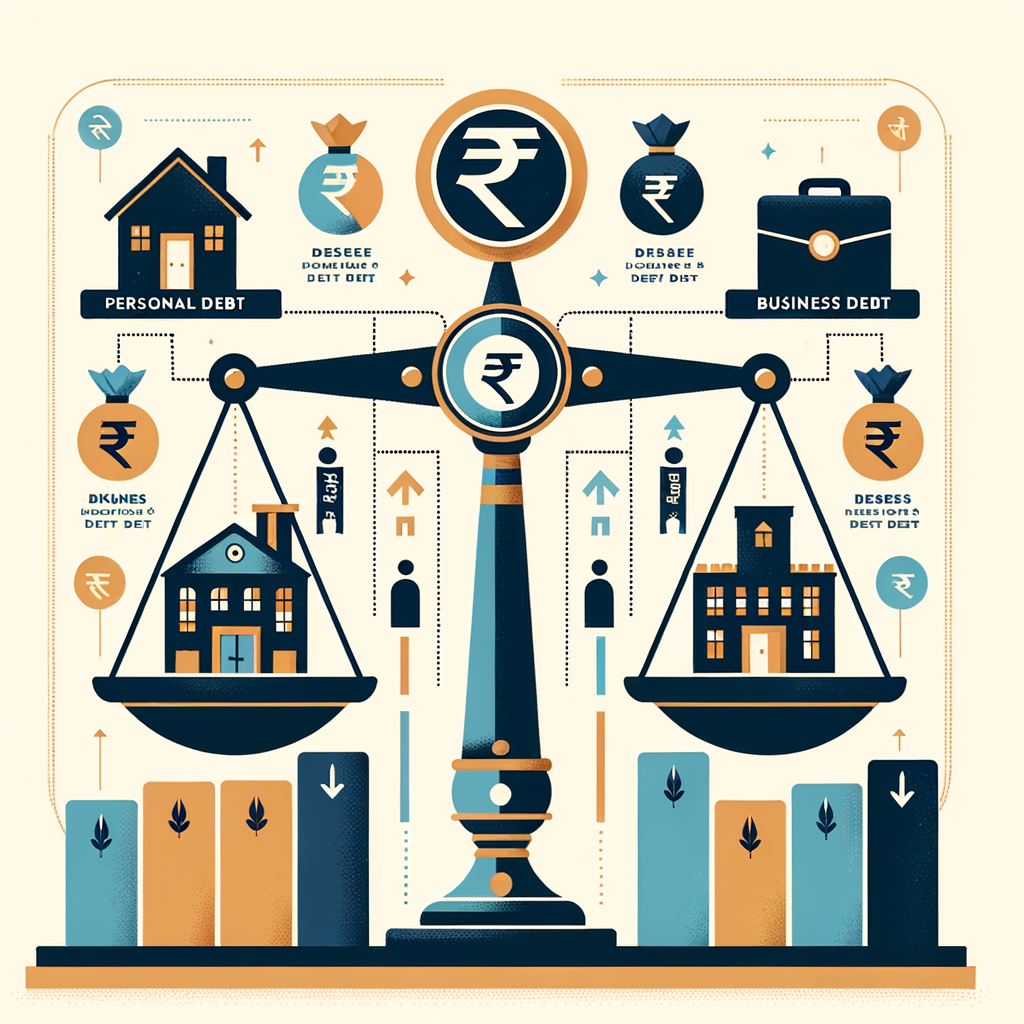Personal Debt vs. Business Debt: A Complete Guide to Managing Both in India
Whether you’re a salaried professional planning a home renovation or a small business owner needing funds for expansion, debt is a common financial tool in India. But not all debt is created equal. Understanding the fundamental differences between personal debt vs. business debt is crucial, as they are structured, managed, and impact your financial health in vastly different ways. This comprehensive guide will break down these critical distinctions, offering actionable strategies and expert personal vs business debt tips India for both salaried individuals and entrepreneurs to navigate their financial journeys successfully.
Understanding the Core Difference: Personal Debt vs. Business Debt
Before diving into management strategies, it’s essential to grasp the fundamental distinction between these two types of liabilities. The purpose, approval criteria, and legal implications for each are worlds apart, and recognizing this is the first step toward effective financial control.
What is Personal Debt?
Personal debt is any money you borrow for personal or household consumption, not for generating income or funding a business venture. It’s tied directly to your individual financial identity and capacity. When you take on personal debt, you are pledging your personal income and assets as a guarantee for repayment.
Common Examples of Personal Debt:
- Home Loans: Borrowed to purchase a residential property.
- Car Loans: Used to finance the purchase of a vehicle for personal use.
- Credit Card Dues: Balances carried on credit cards from personal spending.
- Personal Loans: Unsecured loans taken for various reasons like weddings, travel, medical emergencies, or home improvements.
Key Characteristics:
- Liability: The repayment obligation lies solely with you as an individual.
- Approval Basis: Lenders assess your personal income, employment stability, and most importantly, your CIBIL score.
- Collateral: Your personal assets, like your house or car, can be used as security for the loan.
- Interest Rates: Interest rates, especially for unsecured personal loans and credit cards, are often significantly higher than those for secured business loans.
Effectively managing personal debt in India is paramount for maintaining a healthy CIBIL score, achieving long-term financial goals like retirement, and avoiding a stressful debt cycle.
What is Business Debt?
Business debt is capital borrowed specifically to fund commercial operations. This could range from covering daily operational costs to financing a major expansion or purchasing new equipment. Unlike personal debt, it is directly linked to the financial health and activities of your business entity.
Common Examples of Business Debt:
- Working Capital Loans: Short-term loans to cover operational expenses like payroll and inventory.
- Term Loans: Long-term loans used to purchase significant assets like machinery or property.
- Equipment Financing: Loans specifically for purchasing new business equipment, with the equipment itself often serving as collateral.
- Business Line of Credit: A flexible credit facility that allows a business to draw funds as needed up to a certain limit.
- MSME Loans: Loans provided under government schemes to support Micro, Small, and Medium Enterprises.
Key Characteristics:
- Liability: The business entity (like a Private Limited Company or LLP) is legally responsible for the debt. (Note: We will discuss the exception of personal guarantees later.)
- Approval Basis: Lenders analyze your business’s revenue, cash flow projections, profitability, credit history, and overall business plan.
- Collateral: Business assets such as inventory, accounts receivable, or machinery are typically used as collateral.
- Tax Benefits: A major advantage is that the interest paid on business debt is considered a business expense and is tax-deductible, which lowers your company’s overall tax liability.
Understanding how to leverage and manage business debt is a core component of sound financial strategies for Indian businesses aiming for sustainable growth.
Top Personal Debt Strategies India: A Guide for Salaried Individuals
For salaried individuals, personal debt is often a necessary tool for achieving major life milestones. However, without a clear strategy, it can quickly become overwhelming. Here are proven strategies to take control.
1. Create a Detailed Budget: The 50/30/20 Rule
The foundation of all debt management is knowing exactly where your money is going. The 50/30/20 rule is a simple yet powerful framework to start with:
- 50% for Needs: Allocate half of your after-tax income to essential expenses like housing (rent/EMI), utilities, groceries, and transportation.
- 30% for Wants: This portion covers discretionary spending like dining out, entertainment, hobbies, and shopping. This is the first area to trim when you need to accelerate debt repayment.
- 20% for Savings & Debt Repayment: This crucial part of your income should go towards building an emergency fund, making investments, and, most importantly, paying more than the minimum on your debts.
Actionable Tip: Use a budgeting app or a simple spreadsheet to diligently track your income and expenses for a month. This exercise will reveal spending patterns and highlight areas where you can cut back to free up more cash for debt repayment.
2. Choose Your Repayment Method: Debt Snowball vs. Debt Avalanche
Once you have a budget, you can decide how to attack your existing debts. Two popular methods are the Debt Snowball vs. Debt Avalanche.
- Debt Snowball: With this method, you list your debts from the smallest balance to the largest. You make minimum payments on all debts but throw every extra rupee you have at the smallest one. Once it’s paid off, you “snowball” that payment amount onto the next-smallest debt. The advantage is psychological—clearing small debts provides quick, motivating wins that keep you going.
- Debt Avalanche: This method involves listing your debts by interest rate, from highest to lowest. You make minimum payments on all debts and focus all extra funds on the one with the highest interest rate. Mathematically, this approach saves you the most money over time as you are eliminating the most expensive debt first.
Guidance: Your choice depends on your personality. If you need early victories to stay motivated, the Snowball is for you. If you are disciplined and purely focused on saving money, the Avalanche is the more efficient path for overcoming personal debt India.
3. Explore Debt Consolidation
If you are juggling multiple high-interest debts, such as several credit card balances and a personal loan, debt consolidation might be a viable option. This involves taking out a single, new personal loan to pay off all your other outstanding debts.
- Pros: You simplify your finances with a single EMI to manage. Ideally, the new loan will have a lower interest rate than the average rate of your previous debts, saving you money and helping you pay off the principal faster.
- Cons: Be mindful of processing fees associated with the new loan. Also, ensure the loan tenure isn’t so long that you end up paying more in total interest despite the lower rate. Consolidation is a tool, not a cure; it only works if you commit to not accumulating new high-interest debt.
Effective Business Debt Solutions India: A Guide for Entrepreneurs
For entrepreneurs, debt isn’t just a liability; it’s a tool for growth. Managing it effectively is the difference between scaling your business and stalling it. Here are key strategies for success.
1. Focus on Healthy Cash Flow Management
Positive cash flow is the lifeblood of any business and the single most important factor in its ability to service debt. A profitable business on paper can fail if it doesn’t have enough cash on hand to pay its bills, including loan EMIs.
Actionable Tips:
- Streamline Invoicing: Send invoices promptly and have a clear, consistent follow-up process for overdue payments.
- Incentivize Early Payments: Offer small discounts (e.g., 1-2%) to clients who pay their invoices ahead of schedule.
- Optimize Inventory: Avoid tying up excessive capital in slow-moving stock. Use inventory management techniques to ensure you have what you need without overstocking.
- Negotiate Better Payment Terms: Talk to your suppliers about extending your payment cycles to better align with your revenue collection.
2. Maintain a Favourable Debt-to-Equity Ratio
The Debt-to-Equity (D/E) ratio is a key metric that lenders use to assess your company’s financial risk. It’s calculated by dividing your total liabilities by your shareholder equity. A high D/E ratio indicates that the company is heavily financed by debt, which can be seen as risky by lenders and investors.
Guidance: Aim to keep this ratio at a healthy level (what’s “healthy” varies by industry). You can improve your D/E ratio by:
1. Paying Down Debt: Actively use profits to reduce existing liabilities.
2. Infusing Equity: Bring in more capital, either from your own funds or from investors.
3. Leverage Government Schemes and Refinancing
The Indian government offers several schemes to support MSMEs with accessible and affordable credit.
- Explore Options: Look into schemes like the MUDRA Yojana for micro-units, the Stand-Up India Scheme for entrepreneurs from SC/ST communities and women, and the CGTMSE scheme for collateral-free loans. You can check your eligibility for various MSME benefits on the official Udyam Registration Portal.
- Refinance Strategically: As your business grows and establishes a strong credit history, don’t be afraid to revisit your existing loans. You may be able to refinance your debt at a significantly lower interest rate or with more favourable terms, freeing up cash flow for other business priorities. This is one of the most effective strategies for business debt India.
4. Strictly Separate Business and Personal Finances
This is the golden rule for any serious entrepreneur. Mixing personal and business finances is a recipe for accounting headaches, tax complications, and personal financial risk.
The Benefits of Separation:
- Personal Asset Protection: If your business is a registered entity like a Private Limited Company or LLP, keeping finances separate protects your personal assets from business creditors.
- Simplified Accounting: It makes bookkeeping, tracking expenses, and calculating profits much easier and more accurate.
- Easier Tax Filing: Come tax season, you and your accountant will be grateful for the clear distinction between business income/expenses and personal ones.
- Builds Business Credit: Using a business bank account and credit card helps build a credit history for your company, which is vital for securing larger loans in the future. This is one of the most crucial personal vs business debt tips India.
The Overlap: When Personal and Business Debt Collide
For many small business owners and startups in India, the line between personal and business liability can become blurry due to a common clause in loan agreements: the Director’s Personal Guarantee.
When you sign a personal guarantee, you are personally pledging to repay the business loan if your company defaults. This effectively bypasses the limited liability protection of your company structure (like a Pvt Ltd or LLP) and puts your personal assets—your home, savings, and investments—at risk. Lenders insist on this to mitigate their risk, especially when lending to new or small businesses without a long track record.
Actionable Tip: Never sign a loan agreement without reading it thoroughly. Pay special attention to any clauses regarding personal guarantees. It is highly advisable to consult with a legal or financial expert from a firm like TaxRobo before signing, so you fully understand the personal risk you are undertaking.
Conclusion: Smart Debt Management is Key to Financial Success
Understanding the nuances of personal debt vs. business debt is fundamental to sound financial management. Each serves a different purpose and requires a unique approach. For individuals, effective debt management is about securing personal financial stability and achieving life goals. For businesses, it’s a strategic tool to fuel growth, innovate, and capture market share.
The key takeaway is that both require deliberate, informed strategies. Managing personal debt with budgeting and smart repayment plans ensures individual peace of mind, while managing business debt with a focus on cash flow and financial ratios drives profitability. Navigating debt can be complex. Whether you need help creating a budget or structuring your business finances, TaxRobo’s experts can provide tailored debt management plans in India. Contact us today to secure your financial future!
Frequently Asked Questions (FAQs)
1. Can I use a personal loan for my business in India?
While you can, it’s generally not advisable. Business loans often come with benefits like tax-deductible interest and help build your business’s credit profile. Using a personal loan mixes your finances, prevents you from claiming tax benefits on the interest paid, and puts your personal CIBIL score and assets at direct risk for business activities. It is always better to keep them separate.
2. Is the interest on a business loan tax-deductible?
Yes. Under the Income Tax Act, the interest paid on a loan taken for business purposes is treated as a business expense. This expense is deducted from your gross revenue, which reduces your net taxable profit and, consequently, your overall income tax liability. This is a significant advantage of business debt over personal debt used for business.
3. How does my personal CIBIL score impact my business loan application?
For sole proprietorships, partnerships, and new companies without an established business credit history, lenders heavily scrutinize the personal CIBIL scores of the promoters or directors. A strong personal credit history (typically 750 or above) is often a prerequisite for securing a business loan, as it demonstrates your personal creditworthiness and reliability to the lender.
4. What is the difference between secured and unsecured debt?
Secured debt is backed by collateral—an asset like property, equipment, or inventory that the lender can seize if you fail to repay the loan. Examples include home loans and car loans. Unsecured debt is not backed by any collateral and is approved based solely on your creditworthiness (income and credit score). Examples include credit card debt and most personal loans. Because of the lower risk for the lender, secured loans typically have lower interest rates than unsecured loans.



